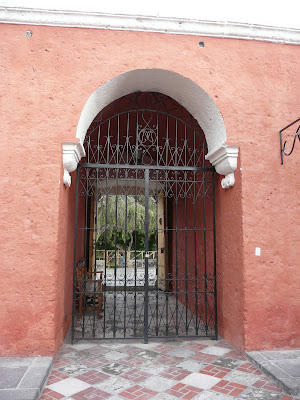The tour began at Plaza de Armas (blue square in the above map), then to Mirador de Carmen Alto, Yanahuara, etc. (in other words counter-clockwise.) The red dots is where stops were made and the blue dots identify geographical points we passed through.
The first stop, Mirador de Carmen Alto, was a view of the Rio Chili and the terraces that have been built and used since the pre-Inca era (amazing!). There is little agriculture that is not irrigated in the area. A closer look at the canals and ditches that bring the water from a higher point in the river to the fields down river and the gates to manage the water would be interesting. One can only imagine all the disputes that must have emerged as the system was developed.
At Yanahuara we viewed a street built to look like a street from a city in Spain.
At Incalpaca we enjoyed watching a vicuña and then a guanaco, and Harold even purchased an alpaca vest. Julie tells Harold that he cannot drink beer while wearing this vest.
The vicuña has the finest wool, and in Inca times only the royalty could wear clothing made from the vicuña.
The guanaco is a territorial animal and to the unwary or those not listening to the tour guide, the guanaco would spit on those that were too close to his fence. This was somewhat humorous, especially since it was not either of us who was spit upon. The guanaco have not been domesticated.
A view of a shanty town (a "new town") as we passed near Huasacache.
Harold at the entrance to the colonial era house built by the Spanish founder of Arequipa. The town was founded in 1540, and the founder was the "governor" and became very wealthy (along with all the rest of the Spaniards who came to Peru).
The entrance into the interior courtyard of the Masion del Fundador was made large enough so the home owner could ride into his house on a horse. The ironwork above the gate contains the initials of the founder GMC (Garcí Manuel de Carbajal).
A water filter. The filter is volcanic rock - the water does pass through, one drop at a time. It takes 6 hours to produce one liter of filtered water.
The rushing water that still runs a grain grinding mill at the mill at Sabandia (Molino de Sabandia).
At the end of the tour the shadows were becoming long. However, the pre-Inca terraces were still impressive.
A great tour!












Hmmm... beer or vest? Tough choice, Harold. I am sure that either you're choose wisely or negotiate some leniency like beer and vest with bib.
ReplyDeleteWe continue to love the pictures!
-Jeff
Good idea about the bib!
ReplyDelete